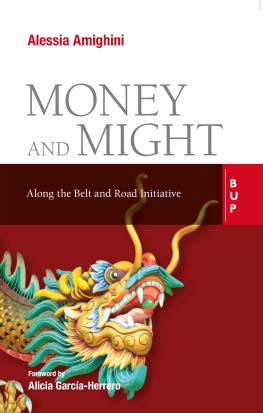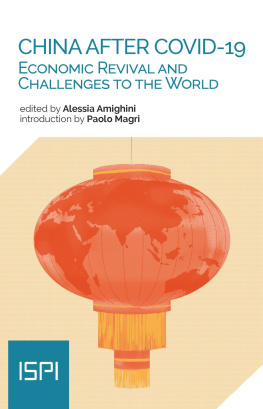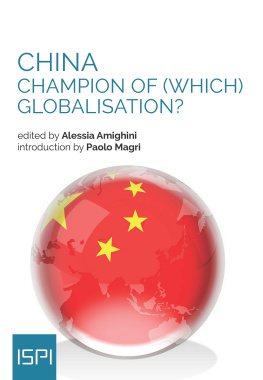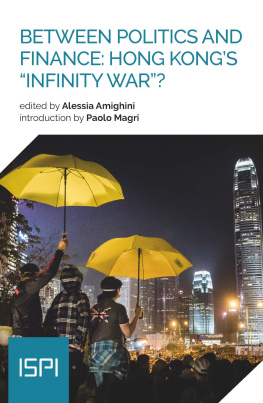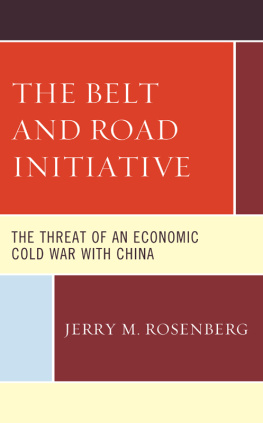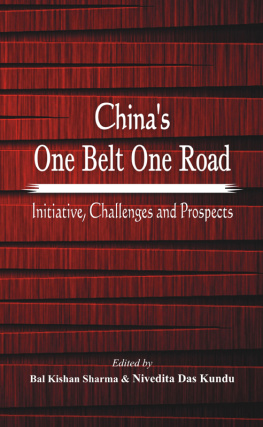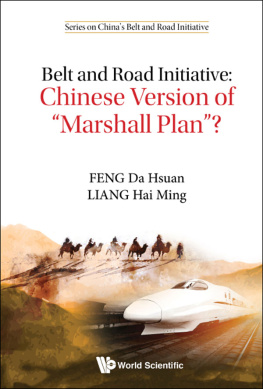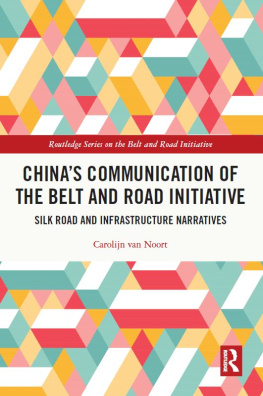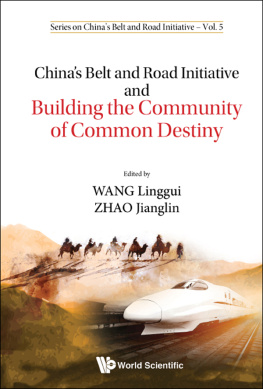Alessia Amighini - Money and Might. Along the Belt and Road Initiative
Here you can read online Alessia Amighini - Money and Might. Along the Belt and Road Initiative full text of the book (entire story) in english for free. Download pdf and epub, get meaning, cover and reviews about this ebook. genre: Politics. Description of the work, (preface) as well as reviews are available. Best literature library LitArk.com created for fans of good reading and offers a wide selection of genres:
Romance novel
Science fiction
Adventure
Detective
Science
History
Home and family
Prose
Art
Politics
Computer
Non-fiction
Religion
Business
Children
Humor
Choose a favorite category and find really read worthwhile books. Enjoy immersion in the world of imagination, feel the emotions of the characters or learn something new for yourself, make an fascinating discovery.
- Book:Money and Might. Along the Belt and Road Initiative
- Author:
- Genre:
- Rating:4 / 5
- Favourites:Add to favourites
- Your mark:
- 80
- 1
- 2
- 3
- 4
- 5
Money and Might. Along the Belt and Road Initiative: summary, description and annotation
We offer to read an annotation, description, summary or preface (depends on what the author of the book "Money and Might. Along the Belt and Road Initiative" wrote himself). If you haven't found the necessary information about the book — write in the comments, we will try to find it.
Money and Might. Along the Belt and Road Initiative — read online for free the complete book (whole text) full work
Below is the text of the book, divided by pages. System saving the place of the last page read, allows you to conveniently read the book "Money and Might. Along the Belt and Road Initiative" online for free, without having to search again every time where you left off. Put a bookmark, and you can go to the page where you finished reading at any time.
Font size:
Interval:
Bookmark:

MONEY AND MIGHT
Launched by President Xi in 2013, the Belt and Road Initiative is at the heart of Chinas internationalization strategy. In addition to the development of transportation infrastructure, trade and communication, it pursues financial cooperation with the rest of the world. Indeed, finance is the real lifeblood of the Initiative, the most innovative and disruptive part in its operational, institutional and political aspects. Through a network of offshore financial centers scattered across the continents, Chinese banks and stock exchanges are increasingly connected with foreign countries, while remaining within a financial system protected by controls on international capital flows, a regime of controlled exchange rate fluctuation and a publicly-owned credit sector. The network functions as a system of communicating vessels that pushes the circulation of the renminbi across borders and the peoples currency becomes an instrument of reverse globalization: it is not China that opens its financial sector to other countries, but the latter that welcome a growing Chinese presence on international markets. Along the BRI, finance flows smoothly and with it the soft power by which China is setting a new course in globalization.
Alessia Amighini
Associate Professor of Economics at the University of Eastern Piedmont, co-Head of the Asia Centre and Senior Associate Research Fellow at ISPI (Italian Institute for International Political Studies). She is author of several articles and scientifi c contributions, and coauthor with Francesco Giavazzi of the European and Italian editions of Olivier Blanchards text, Macroeconomics.

Alessia Amighini
MONEY AND MIGHT
Along the Belt and Road Initiative
Foreword by
Alicia Garca-Herrero
Cover: Cristina Bernasconi, Milan
Typesetting: Laura Panigara, Cesano Boscone (MI)
Copyright 2021 Bocconi University Press
EGEA S.p.A.
EGEA S.p.A.
Via Salasco, 5 - 20136 Milano
Tel. 02/5836.5751 Fax 02/5836.5753
All rights reserved, including but not limited to translation, total or partial adaptation, reproduction, and communication to the public by any means on any media (including microfilms, films, photocopies, electronic or digital media), as well as electronic information storage and retrieval systems. For more information or permission to use material from this text, see the website www.egeaeditore.it
Given the characteristics of Internet, the publisher is not responsible for any changes of address and contents of the websites mentioned.
First edition: June 2021
ISBN Domestic Edition | 978-88-99902-84-1 |
ISBN International Edition | 978-88-31322-12-6 |
ISBN Digital International Edition | 978-88-31322-13-3 |
ISBN Digital Domestic Edition | 978-88-238-8278-2 |
by Alicia Garca-Herrero
The Belt and Road Initiative (BRI) has been widely analyzed by Chinese and international scholars, but less attention has been put to its financial implications. This book by Alessia Amighini is the best piece of work I have read so far that sheds some light on this topic. In fact, the author offers a very comprehensive view of the link between the BRI, as Xi Jinpings landmark project to enhance Chinas soft power, and the internationalization of the renminbi.
The importance of renminbi internationalization for Chinas rise cannot be underestimated. No hegemon has ever been dependent on the currency issued by the previous hegemon and this is what China would need to end up doing once its GDP surpasses that of the US, which based on existing growth projections is bound to happen as early as 2028. In fact, only about 2% of global transactions are denominated in RMB, as opposed to almost 40% in USD. In the same vein, only 2% of global foreign exchange reserves are denominated in RMB, versus over 60% in USD. In other words, China is an economic giant but with a weak currency, in terms of international use.
There are two sets of reasons why this is the case. The first is the size and liquidity of Chinas financial system. Actually, Chinas financial system used to be relatively small for the size of its economy, but that reality has changed rapidly since 2008 as banks balance sheets grew sharply and so did the bond and the stock market. However, liquidity is still not as ample as that of the US financial markets, in fact far from that. Secondly, Chinas currency is not yet convertible since controls remain on Chinas financial account, especially as regards outflows, both of foreign direct investment and even more so of portfolio flows. While the process of Chinas financial opening has been accelerating in recent years, it remains asymmetrical as most of the developments still concentrate in attracting inflows.
China, being fully aware of the potential costs of opening up the financial account too quickly, is trying to square the circle with two main proposals. The first is financing projects along the BRI geographies, using renminbi as funding currency. This book deals with this issue at great length, which makes it an invaluable source of information as to how China is pushing the use of its currency and, more generally, renminbi internationalization.
The second way in which China is pushing its currency is by introducing the first digital currency among major central banks in the world. Chinese policy makers are introducing the digital renminbi, not only for domestic reasons as cash in circulation has shrunk dramatically due to the widespread application of digital payments but also for external reason. A crucial one is to reduce Chinas dependence from the US dollar whether it is for funding or investment purposes. This is even more the case after Trump started a trade war on China, which spread to a tech war with the help of the extraterritoriality of the dollar. The possibility of a financial war is also brewing with the investment ban on Chinese military firms. In other words, the emergence of Chinas own digital currency comes at just the right time as Chinas first mover advantage for its digital currency to be used overseas could enhance the acceptance of the currency whether for funding or investment and, thereby, reduce Chinas dependence on the US dollar. The use of digital currency also offers a new way of capital control through the tracing of financial flows.
This book offers an excellent overview of where we stand in this process and, thereby, become an invaluable source of understanding of how far China is from becoming the worlds hegemon. In fact, Chinas GDP size is one aspect of what is needed. Another key one is the use of the renminbi internationally. Both the BRI and the way it is funded, as well as the overseas use of Chinas digital currency are two important ways in which China can achieve that goal.
All in all, I cannot but recommend reading this thorough analysis by Alessia Amighini on a topic of enormous relevance, not only for China but for the world.
Alicia Garcia-Herrero is a Spanish economist and academic who has been the chief economist for Asia-Pacific at French investment bank Natixis since June 2015.
Font size:
Interval:
Bookmark:
Similar books «Money and Might. Along the Belt and Road Initiative»
Look at similar books to Money and Might. Along the Belt and Road Initiative. We have selected literature similar in name and meaning in the hope of providing readers with more options to find new, interesting, not yet read works.
Discussion, reviews of the book Money and Might. Along the Belt and Road Initiative and just readers' own opinions. Leave your comments, write what you think about the work, its meaning or the main characters. Specify what exactly you liked and what you didn't like, and why you think so.

